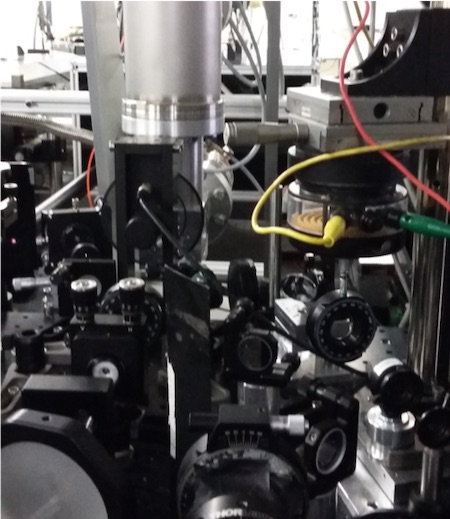
The study of the light-matter interaction has become key to deepen our understanding of the quantum world. Photons with distinct wavelengths and polarizations can inspect matter in different ways, for example, by capturing the elementary excitations that drive specific phase transitions or by revealing if certain symmetries are broken by an emergent order parameter. Optical spectroscopy is a broad term encompassing techniques that analyze the photons leaving a target sample after an interaction: these reflected, transmitted, emitted, or inelastically scattered photons carry distinct information on the studied material, and their detection is therefore crucial to unravel the nature of interactions and correlations in solids.
In our laboratory, we develop sensitive linear and nonlinear optical spectroscopy methods to unveil characteristic fingerprints of emergent phases in quantum materials. Our experimental setups are designed to cover specific portions of the electromagnetic spectrum — ranging from the terahertz to the extreme ultraviolet — and can accommodate samples with very different characteristics, from bulk crystals to moiré heterostructures. In one class of experiments, we search for hitherto undetected elementary excitations that lie in the millielectronvolt spectral range and are directly responsible for various instabilities in quantum materials; we map these oscillatory or diffusive modes with high frequency resolution using time-domain terahertz spectroscopy and inelastic light scattering, and we track how their behavior is influenced by external stimuli such as temperature, strain, and magnetic field. We then search for the presence of optical polarization anisotropies and nonlinear frequency conversions to uncover emergent order parameters that break various symmetries, including time-reversal, space-inversion, and mirror-reflection. We also aim to implement next-generation nonlinear spectroscopy methods to detect interactions among collective modes or unravel the fractionalized excitations of highly entangled quantum phases lacking long-range order. Finally, we plan to extend these studies far away from thermodynamic equilibrium, breaking symmetries artificially with tailored laser pulses and following the spectroscopic fingerprints of transient/metastable quantum phases directly in the time domain. Altogether, these studies will push the optical spectroscopy of quantum materials towards new horizons.
Selected publications:
 , T. Senthil, N. Gedik
, T. Senthil, N. Gedik , “Exciton-Driven Antiferromagnetic Metal in a Correlated van der Waals Insulator,” Nature Communications 12, 4837 (2021)
, “Exciton-Driven Antiferromagnetic Metal in a Correlated van der Waals Insulator,” Nature Communications 12, 4837 (2021) , “Discovery of the Soft Electronic Modes of the Trimeron Order in Magnetite,” Nature Physics 16, 541-545 (2020)
, “Discovery of the Soft Electronic Modes of the Trimeron Order in Magnetite,” Nature Physics 16, 541-545 (2020) , M. A. Sentef, S. Acharya, T. Brumme, E. Sheveleva, F. Lyzwa, E. Pomjakushina, C. Bernhard, M. van Schilfgaarde, F. Carbone, A. Rubio
, M. A. Sentef, S. Acharya, T. Brumme, E. Sheveleva, F. Lyzwa, E. Pomjakushina, C. Bernhard, M. van Schilfgaarde, F. Carbone, A. Rubio , C. Weber
, C. Weber , “Electron-Phonon-Driven Three-Dimensional Metallicity in an Insulating Cuprate,” Proceedings of the National Academy of Sciences 117, 6409-6416 (2020)
, “Electron-Phonon-Driven Three-Dimensional Metallicity in an Insulating Cuprate,” Proceedings of the National Academy of Sciences 117, 6409-6416 (2020) , “Terahertz-Field-Induced Ferroelectricity in Quantum Paraelectric SrTiO3,” Science 364, 1079-1082 (2019)
, “Terahertz-Field-Induced Ferroelectricity in Quantum Paraelectric SrTiO3,” Science 364, 1079-1082 (2019) , L. Chiodo, A. Dominguez, M. Palummo, S. Moser, M. Yazdi-Rizi, G. Auböck, B. P. P. Mallett, H. Berger, A. Magrez, C. Bernhard, M. Grioni, A. Rubio, M. Chergui
, L. Chiodo, A. Dominguez, M. Palummo, S. Moser, M. Yazdi-Rizi, G. Auböck, B. P. P. Mallett, H. Berger, A. Magrez, C. Bernhard, M. Grioni, A. Rubio, M. Chergui , “Strongly Bound Excitons in Anatase TiO2 Single Crystals and Nanoparticles,” Nature Communications 8, 13 (2017)
, “Strongly Bound Excitons in Anatase TiO2 Single Crystals and Nanoparticles,” Nature Communications 8, 13 (2017)